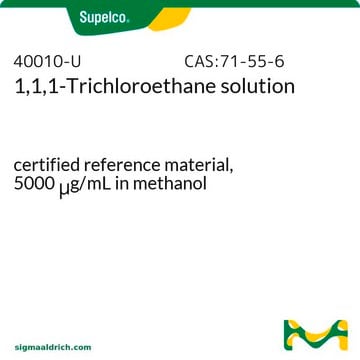If this product has an expiration or retest date, it will be shown on the Certificate of Analysis (COA, CofA). If there is no retest or expiration date listed on the product's COA, we do not have suitable stability data to determine a shelf life. For these products, the only date on the COA will be the release date; a retest, expiration, or use-by-date will not be displayed.
For all products, we recommend handling per defined conditions as printed in our product literature and website product descriptions. We recommend that products should be routinely inspected by customers to ensure they perform as expected.
For products without retest or expiration dates, our standard warranty of 1 year from the date of shipment is applicable.
For more information, please refer to the Product Dating Information document: https://www.sigmaaldrich.com/deepweb/assets/sigmaaldrich/marketing/global/documents/449/386/product-dating-information-mk.pdf
251402
Trichloroethylene
ACS reagent, ≥99.5%
Synonym(s):
TCE, Trichloroethene
Select a Size
Select a Size
About This Item
Recommended Products
grade
ACS reagent
Quality Level
vapor density
4.5 (vs air)
vapor pressure
61 mmHg ( 20 °C)
Assay
≥99.5%
form
liquid
autoignition temp.
770 °F
dilution
(for analytical testing)
impurities
Free halogens, passes test
≤0.0001 meq/g Titr. acid
≤0.0003 meq/g Titr. base
≤0.02% water
evapn. residue
≤0.001%
color
APHA: ≤10
refractive index
n20/D 1.476 (lit.)
bp
86.7 °C (lit.)
mp
−84.8 °C (lit.)
density
1.463 g/mL at 25 °C (lit.)
cation traces
heavy metals (as Pb): ≤1 ppm
SMILES string
Cl\C=C(\Cl)Cl
InChI
1S/C2HCl3/c3-1-2(4)5/h1H
InChI key
XSTXAVWGXDQKEL-UHFFFAOYSA-N
Looking for similar products? Visit Product Comparison Guide
Related Categories
General description
Application
- As a solvent in the C- and O-glycosylation reactions of tetrahydropyran acetals and 2-deoxyglucopyranosides to prepare SN2 products.
- In the chemical industry for the synthesis of polyvinyl chloride, chloroacetic acid, hydrofluorocarbons, pharmaceuticals, insecticides, fungicides, fire retardants, fertilizer, and synthetic rubber.
- As a starting material in the synthesis of dichloroacetylene.
- As a reagent in the preparation of alkynic ethers.
- As a reagent for ethynylation and vinylation process.
Signal Word
Danger
Hazard Statements
Precautionary Statements
Hazard Classifications
Aquatic Chronic 3 - Carc. 1B - Eye Irrit. 2 - Muta. 2 - Skin Irrit. 2 - Skin Sens. 1B - STOT SE 3
Target Organs
Central nervous system
Storage Class Code
6.1D - Non-combustible acute toxic Cat.3 / toxic hazardous materials or hazardous materials causing chronic effects
WGK
WGK 3
Flash Point(F)
closed cup - does not flash
Flash Point(C)
closed cup - does not flash
Regulatory Listings
Regulatory Listings are mainly provided for chemical products. Only limited information can be provided here for non-chemical products. No entry means none of the components are listed. It is the user’s obligation to ensure the safe and legal use of the product.
EU REACH SVHC Candidate List
EU REACH Annex XVII (Restriction List)
EU REACH Annex XIV (Authorisation List)
Choose from one of the most recent versions:
Already Own This Product?
Find documentation for the products that you have recently purchased in the Document Library.
-
How can I determine the shelf life / expiration / retest date of this product?
1 answer-
Helpful?
-
-
How is shipping temperature determined? And how is it related to the product storage temperature?
1 answer-
Products may be shipped at a different temperature than the recommended long-term storage temperature. If the product quality is sensitive to short-term exposure to conditions other than the recommended long-term storage, it will be shipped on wet or dry-ice. If the product quality is NOT affected by short-term exposure to conditions other than the recommended long-term storage, it will be shipped at ambient temperature. As shipping routes are configured for minimum transit times, shipping at ambient temperature helps control shipping costs for our customers. For more information, please refer to the Storage and Transport Conditions document: https://www.sigmaaldrich.com/deepweb/assets/sigmaaldrich/marketing/global/documents/316/622/storage-transport-conditions-mk.pdf
Helpful?
-
-
This product can be used for OIW analysis?
1 answer-
This product is an ACS reagent grade trichloroethylene, typically used for synthetic purposes. This item is not tested or recommended for any specific analytical applications, such as oil-in-water analysis.
Helpful?
-
Active Filters
Our team of scientists has experience in all areas of research including Life Science, Material Science, Chemical Synthesis, Chromatography, Analytical and many others.
Contact Technical Service







